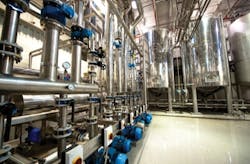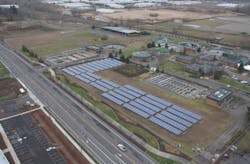Achieving Energy Independence atthe Gresham Wastewater Treatment Plant
By Paul Proctor
Energy is typically one of the top operating costs for wastewater treatment plants. The City of Gresham's wastewater treatment plant, servicing more than 110,000 customers in Gresham and nearby cities just outside of Portland, OR, was no exception.
In 2005, as part of its overall commitment to become one of the nation's most sustainable cities, the City of Gresham took a closer look at its 20 mgd wastewater treatment plant and opportunities that might exist to power the facility using renewable sources of energy. At the same time, the city looked (and continues to look) across its municipal departments to find ways to reduce energy usage and implement alternative energy solutions that are environmentally friendly and fiscally sound.
"The City of Gresham shares a collective vision to achieve 100 percent energy independence at the wastewater treatment plant by 2015," said Alan Johnston, senior engineer, City of Gresham, Oregon.
Because of that vision and the work of an innovative partnership, the wastewater treatment plant at Gresham is on its way to becoming energy independent and energy positive, meaning it may actually produce more energy than it consumes.
Multi-Pronged Approach
Every year, the plant naturally produces nearly 64,000,000 cubic feet of digester gas as a byproduct from its anaerobic digesters, so in 2005, Gresham's Wastewater Services Division commissioned the design and construction of a cogeneration engine that would leverage the digester gas to produce heat and energy that could be used to power and heat the plant. Even before the engine was built, the city sought a partner who could manage its operation and maintenance to maximize energy production. To further enhance the use of the gas and reduce wear on the engine components, the digester gas is treated and conditioned to remove hydrogen sulfide, siloxane and excess moisture.
"We needed a partner with deep experience managing municipal wastewater systems as well as technical expertise and a track record for implementing energy-efficient solutions," said Johnston. "It was important that any potential partner embrace our progressive approach and help us execute against our vision."
Veolia Water North America, a water and wastewater partnership services provider to municipal and industrial customers (part of the Veolia Environnement companies in North America), offered the expertise and environmental stewardship the city was seeking. Veolia Water also agreed to guarantee 90 percent or better "uptime" of the cogeneration engine, meaning it would ensure the engine is fully functional and operating at least 90 percent of the time.
With its vision in mind, the city partnered with Veolia Water to help reach its goal. Under terms of its seven-year contract with the City of Gresham, Veolia Water manages the wastewater treatment plant and oversees operation of the cogeneration engine as well as a robust asset management program.
Optimizing physical assets at the plant, ensuring they are working properly and heading off potential equipment and process inefficiencies and failures also are important in the city's overall approach to driving down energy costs. Veolia Water proposed and implemented an asset management program in Gresham that involves proactively managing the plant's infrastructure. By closely monitoring capital assets and performing routine checks and maintenance, Veolia Water and the city are able to identify and root out inefficiencies and avoid unexpected outages and the related costs of repair and/or replacement and downtime.
At the same time, across the city, efforts remain underway to reduce overall energy usage. At Gresham's wastewater treatment plant, the city and Veolia Water have been able to reduce average monthly energy use by approximately 10 percent through monitoring and reducing the electrical consumption of equipment. In addition the city is implementing process improvements and use of more efficient technologies. These have included both small and large measures - from replacing air diffusers and installing high-efficiency turbo blowers for the aeration system to installing Linear Motion Mixers for the digesters.
Still, the city sought to do more and looked at additional energy alternatives to help it achieve its goal of moving off the grid and becoming truly energy independent. In 2009, the city installed 1,904 ground-mounted solar panels on an acre and a half of land at the wastewater treatment plant. Working in partnership with SunEdison and REC Solar, the city was able to do this at no cost to ratepayers. The solar array, which represents the largest ground mount solar array in the Northwestern United States, generates eight percent of the plant's annual electricity needs.
Veolia Water is responsible for tracking energy produced by the 419 kW solar array. The company also tracks energy produced at the plant from wind power that the city purchases from Portland General Electric. Veolia Water has partnered with the city to split the costs of a wind energy surcharge.
Energy Independence
The city's plan to leverage multiple sources of renewable energy to power the plant is proving successful. Its innovative cogeneration engine is producing more than 50 percent of the plant's energy and contributing to a reduction in electricity costs of approximately $23,000 a month on average. (Veolia Water has delivered on its promise of 90 percent uptime; since the start of its partnership with the city, Veolia Water has ensured cogeneration engine uptime of at least 94 percent annually.) Energy generated by the sun and wind and captured at the plant also is helping to power the plant. In total, nearly 75 percent of the plant's total annual energy comes from the combination of the cogeneration engine, the solar array and clean wind. The money the city is able to save through its use of alternative energies at the wastewater treatment plant can help to ensure stable rates and support other sustainability initiatives.
As of December 1, 2010, the City of Gresham is ranked number three on the U.S. Environmental Protection Agency's list of Green Power Communities based on its annual green power usage.1 The city and Veolia Water are investigating other sources of renewable energy to power the plant and move closer to becoming energy positive. Among their considerations: doubling the cogeneration systems and capturing energy from grease waste that is generated by restaurants and food cooking plants.
WW
About the Author: Paul Proctor is a project manager at Gresham Wastewater Treatment Plant in Gresham, Oregon.
Notes: 1. http://www.epa.gov/greenpower/documents/gpcrankings_dec2010.pdf
More WaterWorld Current Issue Articles
More WaterWorld Archives Issue Articles



